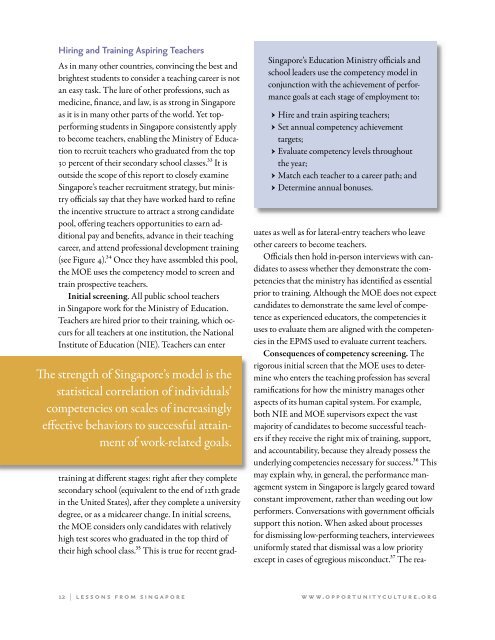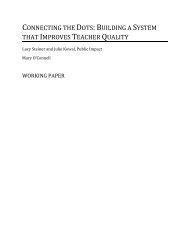Using Competency-Based Evaluation to Drive Teacher Excellence
Using Competency-Based Evaluation to Drive Teacher Excellence
Using Competency-Based Evaluation to Drive Teacher Excellence
You also want an ePaper? Increase the reach of your titles
YUMPU automatically turns print PDFs into web optimized ePapers that Google loves.
Hiring and Training Aspiring <strong>Teacher</strong>s<br />
As in many other countries, convincing the best and<br />
brightest students <strong>to</strong> consider a teaching career is not<br />
an easy task. The lure of other professions, such as<br />
medicine, finance, and law, is as strong in Singapore<br />
as it is in many other parts of the world. Yet <strong>to</strong>pperforming<br />
students in Singapore consistently apply<br />
<strong>to</strong> become teachers, enabling the Ministry of Education<br />
<strong>to</strong> recruit teachers who graduated from the <strong>to</strong>p<br />
30 percent of their secondary school classes.33 It is<br />
outside the scope of this report <strong>to</strong> closely examine<br />
Singapore’s teacher recruitment strategy, but ministry<br />
officials say that they have worked hard <strong>to</strong> refine<br />
the incentive structure <strong>to</strong> attract a strong candidate<br />
pool, offering teachers opportunities <strong>to</strong> earn additional<br />
pay and benefits, advance in their teaching<br />
career, and attend professional development training<br />
(see Figure 4).34 Once they have assembled this pool,<br />
the MOE uses the competency model <strong>to</strong> screen and<br />
train prospective teachers.<br />
Initial screening. All public school teachers<br />
in Singapore work for the Ministry of Education.<br />
<strong>Teacher</strong>s are hired prior <strong>to</strong> their training, which occurs<br />
for all teachers at one institution, the National<br />
Institute of Education (NIE). <strong>Teacher</strong>s can enter<br />
The strength of Singapore’s model is the<br />
statistical correlation of individuals’<br />
competencies on scales of increasingly<br />
effective behaviors <strong>to</strong> successful attainment<br />
of work-related goals.<br />
Singapore’s Education Ministry officials and<br />
school leaders use the competency model in<br />
conjunction with the achievement of performance<br />
goals at each stage of employment <strong>to</strong>:<br />
Hire and train aspiring teachers;<br />
Set annual competency achievement<br />
targets;<br />
Evaluate competency levels throughout<br />
the year;<br />
Match each teacher <strong>to</strong> a career path; and<br />
Determine annual bonuses.<br />
training at different stages: right after they complete<br />
secondary school (equivalent <strong>to</strong> the end of 12th grade<br />
in the United States), after they complete a university<br />
degree, or as a midcareer change. In initial screens,<br />
the MOE considers only candidates with relatively<br />
high test scores who graduated in the <strong>to</strong>p third of<br />
their high school class.35 This is true for recent graduates<br />
as well as for lateral-entry teachers who leave<br />
other careers <strong>to</strong> become teachers.<br />
Officials then hold in-person interviews with candidates<br />
<strong>to</strong> assess whether they demonstrate the competencies<br />
that the ministry has identified as essential<br />
prior <strong>to</strong> training. Although the MOE does not expect<br />
candidates <strong>to</strong> demonstrate the same level of competence<br />
as experienced educa<strong>to</strong>rs, the competencies it<br />
uses <strong>to</strong> evaluate them are aligned with the competencies<br />
in the EPMS used <strong>to</strong> evaluate current teachers.<br />
Consequences of competency screening. The<br />
rigorous initial screen that the MOE uses <strong>to</strong> determine<br />
who enters the teaching profession has several<br />
ramifications for how the ministry manages other<br />
aspects of its human capital system. For example,<br />
both NIE and MOE supervisors expect the vast<br />
majority of candidates <strong>to</strong> become successful teachers<br />
if they receive the right mix of training, support,<br />
and accountability, because they already possess the<br />
underlying competencies necessary for success.36 This<br />
may explain why, in general, the performance management<br />
system in Singapore is largely geared <strong>to</strong>ward<br />
constant improvement, rather than weeding out low<br />
performers. Conversations with government officials<br />
support this notion. When asked about processes<br />
for dismissing low-performing teachers, interviewees<br />
uniformly stated that dismissal was a low priority<br />
except in cases of egregious misconduct.37 The rea-<br />
12 | lessons from singapore www.opportunityculture.org





